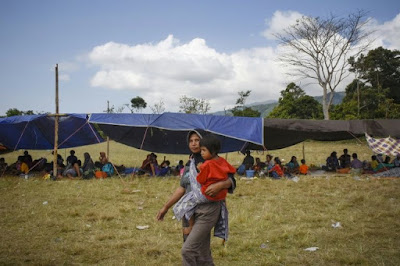 |
| Hikers were able to start descending the mountain Monday after guides discovered an alternate route that was unaffected by the landslides |
More than 500 hikers and guides stranded by landslides on an Indonesian mountain after an earthquake have returned to safety, with some recalling their terror when tonnes of rock cascaded down.
The shallow
6.4-magnitude quake, which struck early Sunday on Lombok island and was
followed by scores of aftershocks, triggered major landslides on Mount Rinjani,
blocking the hiking routes that criss-cross it.
Some 800
trekkers and their guides were on the mountain when the quake struck including
citizens from the United States, France, the Netherlands, Thailand, Germany and
21 other countries, according to search and rescue officials.
Hundreds
managed to find a way down on Sunday and over 500 more reached safety Monday
night.
While most
were able to pick their way down the mountain on foot, at least three arrived
at Sembalun village on the lower slopes by helicopter, according to officials.
Some
returned with harrowing tales of being caught out by the quake, which killed 17
people across the holiday island including one on the mountain.
 |
At least 16
people were killed in the earthquake across affected areas of Lombok,
while
hundreds of buildings were destroyed including a health clinic
|
Australian
hiker Stanley Yu said the ground began to shake about 20 minutes after his
group reached Rinjani’s peak.
"The
earthquake lasted about 10-20 seconds. After that everybody was rushing
down," he told AFP.
"On
the way down there was another earthquake and that made everyone panic -- it
was pretty scary."
One Thai
tourist, who reached the foot of the mountain Tuesday morning, felt the ground
shake beneath her sleeping bag.
"I
felt the earth move... and thought 'Huh? What’s happening?'" she said.
"I got
out of my bed and then I saw a landslide (with) rocks falling down."
A male friend
said he watched parts of Rinjani's slopes collapse.
"The
whole mountain, rocks, fell down -- I was a bit afraid," he said.
 |
Map showing
the area on Lombok, Indonesia, where hikers were trapped
after an earthquake
|
'Tired
but in good condition'
The
remaining 500 or so hikers were able to start climbing down on Monday after
guides discovered an alternate route that was unaffected by the landslides.
The last
three trekkers -- two porters and a guide -- are expected to arrive at the base
of the mountain by 7pm local time, said Agus Hendra Sanjaya, a spokesman for
the search and rescue agency on the island's main city of Mataram.
"We
have searched the (Rinjani) area, there are no more hikers," he told AFP.
"We
started this morning at 6am and will continue to monitor the situation for the
next three days from our base at the foot of the mountain in Sembalun."
Most of the
trekkers reached the base of the mountain by late Monday evening, according to
I Gusti Lanang Wiswananda, another spokesman from the Mataram search and rescue
agency.
"They
were all tired but in good condition and were checked by our medical teams on
the ground upon arrival," he told AFP.
Helicopters
and search teams had been deployed to scour the mountain's slopes and drop food
supplies for those stranded on it.
 |
More than
7,500 people are staying in temporary shelters and in need of clean
water,
according to officials
|
Thousands
of buildings were destroyed across Lombok, including a health clinic.
National
disaster mitigation agency spokesman Sutopo Purwo Nugroho said more than 220
people suffered serious injuries.
A Malaysian
tourist was among the dead, with another six citizens injured, the foreign
ministry in Kuala Lumpur has said.
A total of
7,593 people are staying in temporary shelters, according to officials.
The
3,726-metre (12,224-feet) Rinjani is the second-highest volcano in Indonesia
and a favourite among sightseers.
Its hiking
trails were closed following the quake due to fear of further landslides.
The
epicentre of the earthquake was 50 kilometres (30 miles) northeast of Mataram,
far from the main tourist spots on the south and west of the island.
The initial
tremor was followed by two strong secondary quakes and more than 100
aftershocks.






No comments:
Post a Comment